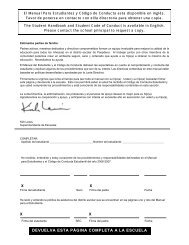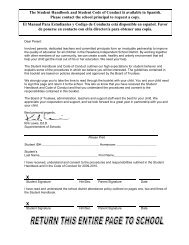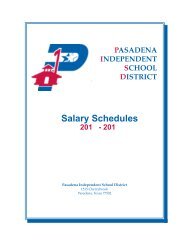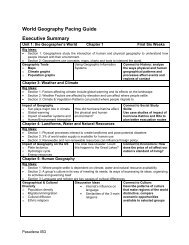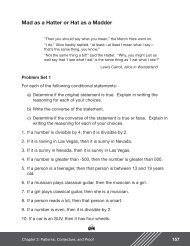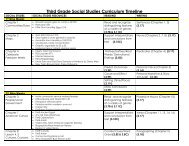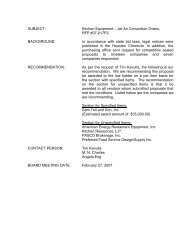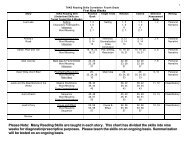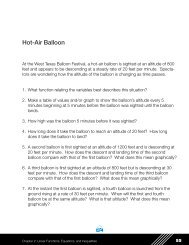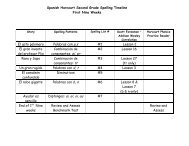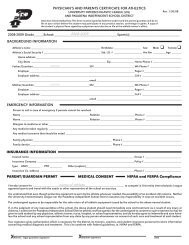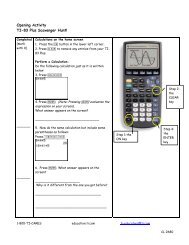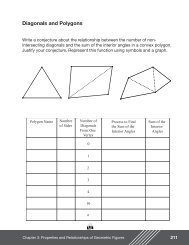T-Shirts - Pasadena Independent School District
T-Shirts - Pasadena Independent School District
T-Shirts - Pasadena Independent School District
Create successful ePaper yourself
Turn your PDF publications into a flip-book with our unique Google optimized e-Paper software.
T-<strong>Shirts</strong><br />
A school organization has found four different places from which they may place an<br />
order for t-shirts. Each function below could represent the cost of placing a t-shirt<br />
order as a function of the number of t-shirts purchased.<br />
A) c = 5t<br />
B) c = 3.25t + 55<br />
C) c = 3t + 100<br />
D) c = 6t – 55<br />
1. Write a scenario for each function.<br />
2. Do all four functions fit a t-shirt situation? Explain your answer.<br />
3. Make a table for each function.<br />
4. Graph each function.<br />
5. Describe the differences in the domain for the function and the domain for your<br />
problem situation.<br />
6. Describe the differences in the range for the function and the range for the<br />
problem situation.<br />
H<br />
Chapter 2: Linear Functions, Equations, and Inequalities<br />
87
Teacher Notes<br />
Scaffolding Questions:<br />
Materials:<br />
One graphing calculator per student.<br />
Connections to Algebra I TEKS and<br />
Performance Descriptions:<br />
(b.1) Foundations for functions.<br />
The student understands that a function<br />
represents a dependence of one quantity on<br />
another and can be described in a variety of<br />
ways.<br />
The student:<br />
(D) represents relationships among quantities<br />
using concrete models, tables, graphs, diagrams,<br />
verbal descriptions, equations, and inequalities.<br />
(b.2) Foundations for functions.<br />
The student uses the properties and attributes of<br />
functions.<br />
The student:<br />
(B) for a variety of situations, identifies the<br />
mathematical domains and ranges and<br />
determines reasonable domain and range values<br />
for given situations;<br />
(c.1) Linear functions.<br />
The student understands that linear functions<br />
can be represented in different ways and<br />
translates among their various representations.<br />
The student:<br />
(B) determines the domain and range values for<br />
which linear functions make sense for given<br />
situations; and<br />
• What is the dependent variable?<br />
• What is the independent variable for each situation?<br />
• In situation A what must 5 represent?<br />
• In situation B which constant represents the cost per t-shirt?<br />
• In situation B what might the constant 55 represent?<br />
• In situation C what does the 3 represent?<br />
• In situation C what might the constant 100 represent?<br />
• In situation D which constant represents the cost per t-shirt?<br />
• In situation D what might the constant -55 represent?<br />
• In situation D think about someone selling you the shirts at a constant rate<br />
but giving you a set discount.<br />
Sample Solution:<br />
1. A) Juan made a great deal with the manager of T-<strong>Shirts</strong> Plus. If the Math<br />
Club places an order of shirts, the cost will be $5.00 per shirt.<br />
B) The Spanish Club feels they have a better deal because they will<br />
get their t-shirts for only $3.25 each. They do have to pay a $55.00<br />
set-up fee.<br />
C) The Math Club found another better deal. They will only pay $3.00<br />
per shirt with a $100.00 set-up fee.<br />
D) The President of the Freshman class thinks he has the best deal:<br />
his father’s friend will sell them shirts for $6.00 each and give him a<br />
$55.00 discount.<br />
(C) translates among and uses algebraic, tabular,<br />
graphical, or verbal descriptions of linear<br />
functions.<br />
H<br />
88
2. Yes, function A is the cost per shirt with no set-up fee, B and C both<br />
show the cost per shirt plus a set-up fee, and D shows cost per shirt<br />
with a discount.<br />
3.<br />
Texas Assessment of Knowledge and Skills:<br />
Objective 4:<br />
The student will formulate and use linear<br />
equations and inequalities.<br />
Connections to Algebra I: 2000 and Beyond<br />
Institute:<br />
I. Foundations for Functions<br />
1 Developing Mathematical Models<br />
1.2 Valentine’s Day Idea<br />
II. Linear Functions<br />
1 Linear Functions<br />
1.2 The Y- Intercept<br />
3 Linear Equations and Inequalities<br />
3.1 Solving Linear Equations<br />
Connections to Algebra End-of-Course<br />
Exam:<br />
Objective 8:<br />
The student will use problem-solving strategies<br />
to analyze, solve, and/or justify solutions to realworld<br />
and mathematical problems involving onevariable<br />
or two-variable situations.<br />
H<br />
Chapter 2: Linear Functions, Equations, and Inequalities<br />
89
4.<br />
5. The domain of each function is all real numbers, because each function is<br />
a linear function. For the t-shirt situation the domain values must be whole<br />
numbers because shirts can not be purchased in fractions.<br />
6. The range of each function is all real numbers. However, in the t-shirt<br />
scenario the amounts will be restricted to dollar values depending on the<br />
situation. For example, in situation B the amounts must be $55 plus a<br />
whole number multiple of $3.25.<br />
H<br />
90
Extension Questions:<br />
• In situation A if the company had decided to give you a discount of $40,<br />
how would that change the equation?<br />
The equation would become c = 5t – 40.<br />
• From which t-shirt company should the group purchase the shirts if they<br />
are going to purchase 50 shirts?<br />
By examining the table or the graph, one can see that the cost for 50 shirts is<br />
the least in situation B.<br />
• Will situation B always give the least cost?<br />
Situation C and B have the same cost at 180 shirts. After that number<br />
situation C has a smaller cost. This can be determined from examining the<br />
graph or table, or by solving symbolically.<br />
H<br />
Chapter 2: Linear Functions, Equations, and Inequalities<br />
91
92<br />
H



